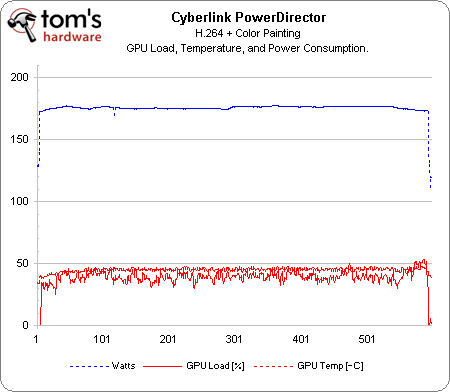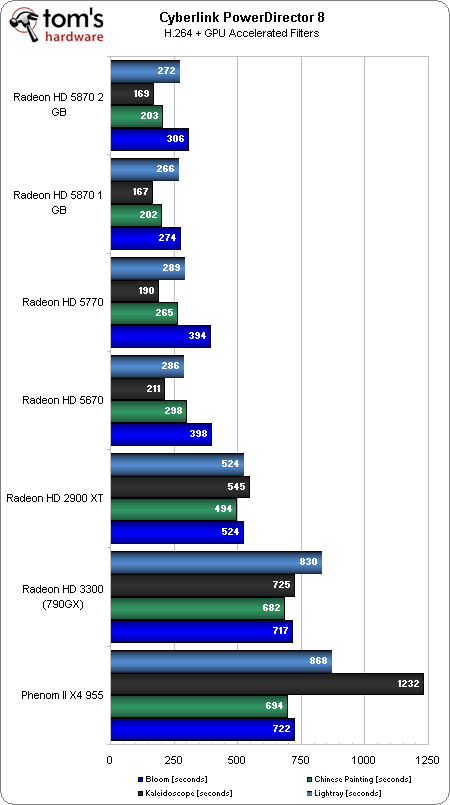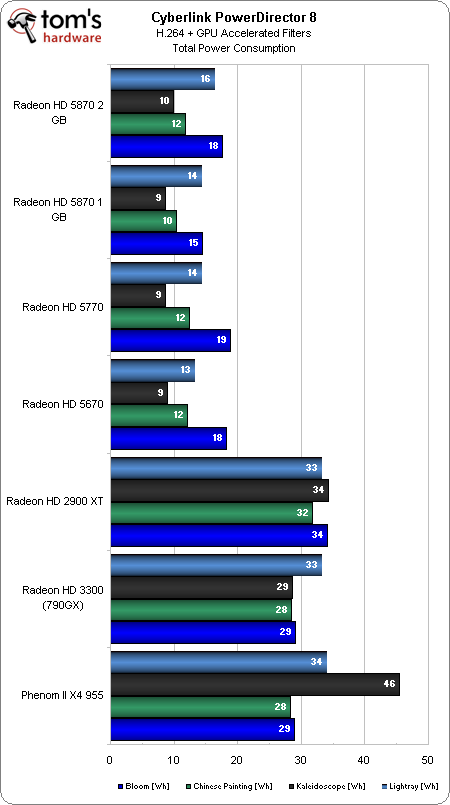AMD's Radeon HD 5000-Series: Measuring Power Efficiency
Most of our graphics card reviews include power measurements at idle and load. But how do applications tax your GPU in between those two extremes? We line up a handful of different programs and monitor power use with a handful of AMD's latest cards.
Benchmark Results: Cyberlink PowerDirector
Next up is Cyberlink's PowerDirector. We actually tested all Stream-supported filters for this article. However, for simplicity's sake, we’re only displaying results from four filters (Bloom, Chinese Painting, Kaleidoscope, and Light Ray), while encoding H.264 video with the default profile (AVCHD 1080p, 15 Mbit). We've selected the aforementioned filters because they seem to respond most readily to GPU acceleration.
With a Radeon HD 4670, GPU utilization stays below 50% most of the time with just GPU filters. The Radeon HD 4670 power consumption levels here are actually quite close to levels when running Crysis (172 W).
We see around 60-70% utilization on both the Radeon HD 5670 and HD 5770 during these tests. Any GPU supporting the use of hardware encoding really stands out, offering very significant improvements beyond CPU-only performance (in our case, with AMD’s Phenom II X4 955 BE).
On that note, even the Radeon HD 3300 offers some savings, but the benefits are limited to filters that it can handle. In this case, only the Kaleidoscope filter qualifies. The three other filters don't show much improvement. One thing to note is that, although there’s virtually no difference in the results, CPU utilization is indeed lower with the Radeon HD 3300. Employing integrated graphics, the CPU doesn’t have to decode the stream and process the filters.
Looking at the total power consumed, both the Radeon HD 5670 and HD 5770 consume roughly the same amount of power throughout the entire process. So, unlike in Crysis and Cinebench, the Radeon HD 5770’s additional performance offsets the slightly higher power consumption. We wouldn't be aware of this fact if we only looked at average power consumption.
We made an interesting observation about the two Radeon HD 5870 cards in this test, too. Instead of operating at full-speed, both boards run at UVD clocks (400/900 MHz). This allows the cards to manage their power consumption very cleverly. The Radeon HD 5870 1 GB is only consuming about 15-21 W more power than the HD 5770. When performance is taken into account, total power consumed between the HD 5670, HD 5770, HD 5870 1GB, and HD 5870 2 GB is similar. The Radeon HD 5870 1 GB edges out the others, but the lead is very small.
On the flip side, there is another lesson to be learned here. Although the Radeon 2900 XT is still faster than a pure software approach, the higher power consumption of the system with the card actually results in higher total power consumed. This is a prime reason why reducing graphics-oriented power consumption is so important in applications that don’t fully utilize the hardware. With its latest-generation boards, AMD has done very well in this regard. Based on the Chinese Painting and Light Ray numbers, a modern GPU architecture like the one used to create AMD’s Radeon HD 5000-series actually cuts down your power usage by more than half compared to the older design.
Get Tom's Hardware's best news and in-depth reviews, straight to your inbox.
Current page: Benchmark Results: Cyberlink PowerDirector
Prev Page Benchmark Results: Cyberlink PowerDVD 9 Next Page GPU Vs. CPU-
tony singh Very innovative article tom keep it up!! Similar article consisting of various cpus would be really useful.Reply -
spidey81 I know the FPS/watt wouldn't be as good, but what if the 5670 was crossfired. Would it still be a better alternative, efficiency wise, than say a 5850?Reply -
nforce4max Remember the R600 (2900xt) has a 80nm core while the 5870 has a 45nm core. Shrink the R600 and you will get the 3870 (55nm) that barely uses hardly any.Reply -
rhino13 And now just for fun we should compare to Fermi.Reply
Oh, wait, this just in:
There is a Fermi comparison chart that was avalible but you needed to have two screens to display the bar graph for Fermi's power consumption and temperature. So the decission was made to provide readers with the single screen only version.
-
aevm I loved this part:Reply
A mere 20 watts separate the Radeon HD 3300, HD 5670, HD 5770, and HD 5870 1 GB. So, in certain cases, the Radeon HD 5870 1 GB can still save enough power to close in on its more mainstream derivatives. Again, this is the case because the cards use a fixed-function video engine to assist in decoding acceleration, which is the same from one board to the next. Thus, even a high-end card behaves like a lower-end product in such a workload. This is very important, as you will see later on.
My next PC will be used mostly for movie DVDs and Diablo 3. Apparently if I get a 5870 1GB I get the best of both worlds - speed in Diablo and low power consumption when playing movies.
How about nVidia cards, would I get the same behavior with a GTX 480 for example?
-
Onus For those not needing the absolute maximum eye candy at high resolutions in their games, the HD5670 looks like a very nice choice for a do-it-all card that won't break the budget.Reply
Next questions: First, where does the HD5750 fall in this? Second, if you do the same kinds of manual tweaking for power saving that you did in your Cool-n-Quiet analysis, how will that change the results? And finally, if you run a F@H client, what does that do to "idle" scores, when the GPU is actually quite busy processing a work unit? -
eodeo Very interesting article indeed.Reply
I'd love to see nvidia cards and beefier CPUs used as well. Normal non green hdds too. Just how big of a difference in speed/power do they make?
Thank you for sharing. -
arnawa_widagda Hi guys,Reply
Thanks for reading the article.
Next questions: First, where does the HD5750 fall in this? Second, if you do the same kinds of manual tweaking for power saving that you did in your Cool-n-Quiet analysis, how will that change the results? And finally, if you run a F@H client, what does that do to "idle" scores, when the GPU is actually quite busy processing a work unit?
Have no 5750 sample yet, but they should relatively be close to 5770. For this article, we simply chose the best bin for each series (Redwood, Juniper and Cypress).
The second question, what will happen when you tweak the chip? Glad you ask!! I can't say much yet, but you'll be surprised what the 5870 1 GB can do.
As for NVIDIA cards, I'm hoping to have the chance to test GF100 and derivatives very soon.
Take care.


